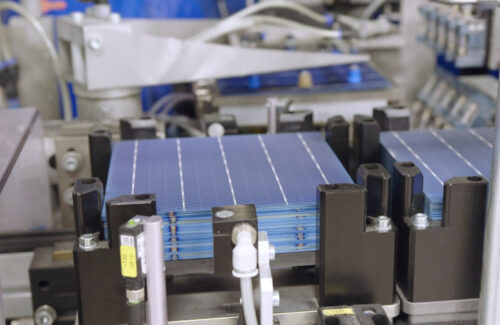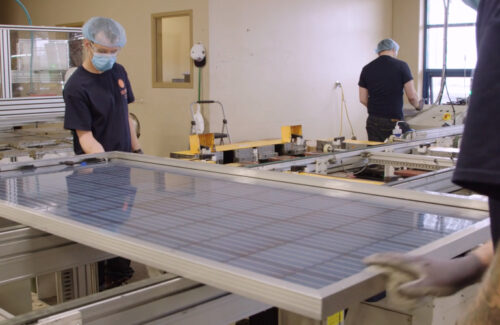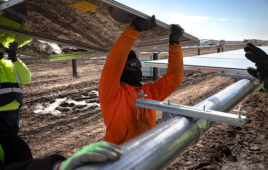By Martin Pochtaruk, president of Heliene
U.S. solar installations are expected to decline this year for the first time after several years of continuous quarter-over-quarter growth. Solar panel prices are the highest they’ve been since 2014 in every market segment due to increased raw material input costs and freight costs. These supply chain constraints have caused industry analysts to lower their 2022 forecasts by as much as 25%.

Inside Heliene’s factory. Courtesy Vimeo
The United States imports about 90% of its solar panels from overseas. Despite being the second largest solar market in the world, companies that produce solar modules stateside are relatively few and far between. The United States discovered solar photovoltaic technology in 1954 and dominated global manufacturing in the 1960s and ’70s, until changes in the political and economic landscape gave Japan and Germany an opening to overtake the market. In the late 1990s, China established a government-backed solar manufacturing industry and became the undisputed global price leader almost overnight. The overbuilding of China’s manufacturing capacity between 2008 and 2013 dropped world prices by 80%, and it’s been nearly impossible for U.S. companies to compete with cheap imports ever since.
For decades, it simply did not make economic sense to build solar manufacturing facilities in the United States. Fortunately for energy consumers and the nation’s climate goals, this has started to change. There’s never been a better time to invest in domestic solar manufacturing.
Regulatory changes mean better returns and lower consumer costs
Domestic solar manufacturing is being incentivized in the recently passed Infrastructure Investment & Jobs Act and the Build Back Better Act pending approval in the Senate; both will be instrumental in achieving the Biden administration’s target of 100% carbon-free electricity by 2035.
Within the Build Back Better package, the Solar Energy Manufacturing for America (SEMA) Act includes a 30% tax credit for advanced energy manufacturing facility investments, or a production tax credit at roughly $0.07 per watt for every American-made solar module sold. For a solar manufacturer, that translates to a $25 tax credit for every 360-W residential solar panel, or $37.80 off every 540-W utility-scale solar panel. The SEMA Act also brings a direct tax reimbursement, allowing U.S. manufacturers to claim about 15 to 17% of the product’s total price.
The Build Back Better Act would also increase the federal investment tax credit (ITC) from 26 to 30% of the cost of the system, plus an additional 10% if the components are made in America. In addition, the legislation includes a direct pay option for commercial and residential solar projects in lieu of having to claim the ITC via tax returns. The higher incentive will lower overall project costs, encouraging more solar projects, meaning more sales, and the direct pay option will make solar more accessible to middle and lower income home- and business owners, again translating to more sales.
The passage of the modified ITC would result in an additional 43.5 GW of solar capacity over the next five years, most of which would come from the utility-scale sector, the largest market in the United States by far. While utility-scale solar projects will face supply chain constraints in the near-term, the ITC will partially compensate for price increases.
Exposure to volatility will make customers rethink cost versus risk tradeoff

Inside Heliene’s factory. Courtesy Vimeo
Solar panel imports into the United States have already begun to decrease due to supply chain concerns and trade relations. Imports were down 27% in the third quarter of 2021 compared to the second quarter, and down 11% compared to the third quarter of 2020. Domestic manufacturers can expect to see an increase in sales as project developers and distributors are looking for new suppliers while supply chain woes wage on.
But even if materials and shipping costs eventually stabilize, prudent customers will remember the pressure their business faced during this time and will want to hedge against these risks going forward. The current supply chain crisis has highlighted the competitive advantages of buying from domestic manufacturers, chiefly among them certainty of supply and lower shipping costs. Before 2021, the cost of shipping solar panels had a minimal impact on overall production capital expenditure. But pandemic-era shipping delays have resulted in a 500% price increase, from $0.015 per Watt peak (Wp) in September 2019 to $0.085/Wp in October 2021. Plus, hundreds of megawatts of modules were detained by Customs and Border Protection last year over justified concerns of forced labor in China and other trade violations.
Although the U.S. solar manufacturing industry currently only has the capacity to produce about one-third of the domestic demand, several companies have announced plans to build new or expand factories on the homefront, which could double capacity within the next two years. With the new slate of supportive federal policies and access to customers previously unavailable to them, solar manufacturers around the world would be wise to seize the opportunity to invest in the U.S. market.
Conclusion
Current supply chain challenges are not unique to the solar industry nor to the United States, but rather the global clean energy transition writ large is at risk of losing precious progress. The business intelligence firm Rystad Energy has predicted that rising costs could prompt the delay or cancellation of as much as 56% of the solar generation capacity currently planned worldwide in 2022. The firm also reported that the levelized cost of energy of new solar projects has risen by 10 to 15% from last year. Other cleantech sectors like energy storage, for example, will also experience declines in deployment this year. For example, lithium-ion battery prices have recently increased by 10 to 20%, and price declines are not predicted to resume again until 2024, according to IHS Markit.
Rising costs of solar imports and a lack of clarity for the industry could deter the United States’ ambitious goals to produce 45% of the nation’s electricity from the sun by 2050. To do this, the United States will need to install an average of 30 GW of solar capacity per year between now and 2025, then 60 GW per year from 2025. The fate of the U.S. solar industry and the nation’s ability to contribute to international climate commitments depends on continued improvements in the business conditions of domestic manufacturing, and the organizations that invest in domestic solar now will have assurance of greater stability down the line.
 Martin Pochtaruk has over 30 years of experience managing manufacturing and innovation businesses across Europe and the Americas. He founded Heliene, a technology leading high quality solar PV module manufacturer in 2010, the company is challenging the solar industry status quo by putting customers first. It’s doing so as well by manufacturing high quality, competitively priced solar PV modules made to order in North America. By supporting customers with its in-house logistics team and just in time supply chain solutions. And by being remarkably responsive.
Martin Pochtaruk has over 30 years of experience managing manufacturing and innovation businesses across Europe and the Americas. He founded Heliene, a technology leading high quality solar PV module manufacturer in 2010, the company is challenging the solar industry status quo by putting customers first. It’s doing so as well by manufacturing high quality, competitively priced solar PV modules made to order in North America. By supporting customers with its in-house logistics team and just in time supply chain solutions. And by being remarkably responsive.





Tell Us What You Think!